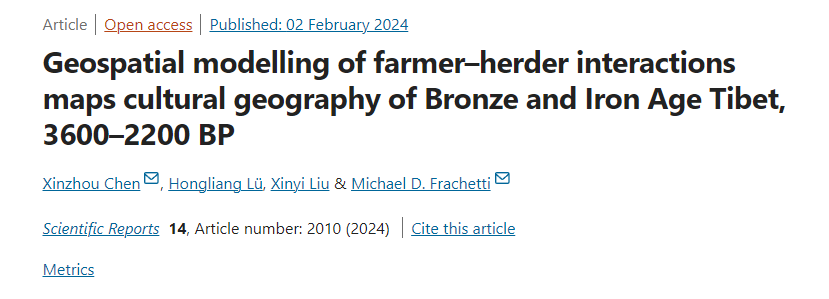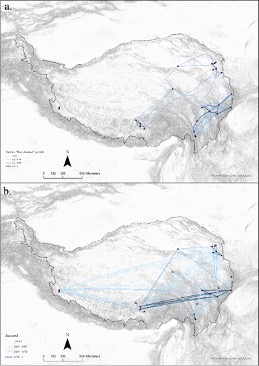Center for Archaeological Science, Sichuan University publishes article in international journal revealing the pattern of cultural exchange in the Bronze to Iron Age on the Tibetan Plateau and its geographical drivers.
Center for Archaeological Science, Sichuan University Published an Article in International Journal Revealing the Pattern and Geographical Driving Force of Cultural Exchange in the Bronze to Iron Age on the Qinghai-Tibet Plateau

Recently, the Center for Archaeological Science, Sichuan University, in collaboration with archaeologists from Washington University in St. Louis, completed a research paper on the pattern of prehistoric cultural exchange on the Qinghai-Tibet Plateau, entitled "Geospatial modelling of farmer鈥揾erder interactions maps cultural geography of Bronze and Iron Age Tibet, 3600鈥�2200 BP", published online in the multidisciplinary scientific journal ScientificReports under SpringerNature (doi: https://doi.org/10.1038/s41598-023-50556-9). This study combines pottery typology, GIS modeling, and pottery social network analysis to quantitatively analyze the relationship between cultural exchange patterns and agro-pastoral interaction routes during the study period, and explains the driving forces of cultural exchange. In recent years, the application of network analysis in archaeology has become a cutting-edge topic in the international academic community. In this context, this study integrates network analysis with the rich practice of artifact typology in Chinese archaeology, extending the connotation and explanatory power of traditional archaeological research. This study is also the first successful attempt of pottery network analysis in the archaeology of the Qinghai-Tibet Plateau.
Multidisciplinary archaeometric results show that with the widespread spread of domesticated animals and plants after about 3600 BP, agriculture and animal husbandry gradually dominated prehistoric livelihoods on the Qinghai-Tibet Plateau. Cultural genealogy research based on artifact typology and the spatial distribution data of sites accumulated over many years of archaeological work also show that the intensity and breadth of cultural exchange on the Qinghai-Tibet Plateau increased significantly during this period, and the spatial range of site distribution expanded to a large number of high-altitude areas. This dramatic change in cultural exchange patterns and settlement patterns still lacks a comprehensive archaeological explanation.
In response to this research gap, in order to explore what factors led to the cultural exchange pattern after 3600 BP, this paper constructed two computer models based on a comprehensive archaeological site database: one is a farmer-herder interaction model (SIMM) that simulates the movement routes of farmers and herders; the other is a pottery social network that quantitatively describes the pattern of cultural exchange. Based on the qualitative comparison of archaeological typology research and computer models, this study explores the formation mechanism of the cultural exchange pattern on the Qinghai-Tibet Plateau from 3600-2200 BP.
Based on the assumption that herders "live by water and grass", the farmer-herder interaction model in this study uses vegetation distribution data provided by satellite remote sensing database to simulate the optimal path for ancient people to move along the best pasture to agricultural areas. This farmer-herder interaction network is highly consistent with the site distribution on the Qinghai-Tibet Plateau from 3600-2200 BP, showing that the theoretical optimal livelihood movement route is positively correlated with the spatial distribution pattern of settlements.
How did this movement pattern create the cultural exchange pattern of this period? This study uses the similarity of published pottery from sites in this period to quantitatively construct a pottery social network. The network describes the intensity of cultural exchange between archaeological sites during this period. Theoretically, the pasture-rich channels frequently used by farmer-herder interactions are like the highways commonly used today: the closer to this "highway", the faster the cultural exchange should be, and the more similar the cultural appearance of the site should be.
Interestingly, the comparison of the two networks shows that the cultural interaction pattern on the Qinghai-Tibet Plateau and the geographical pattern of farmer-herder interaction have regional differences. In the eastern Qinghai-Tibet Plateau, the intensity of farmer-herder interaction is roughly consistent with the degree of pottery similarity, showing that the material cultural exchange in this region is indeed related to the farmer-herder interaction routes on the plateau; while in the western plateau, the intensity of farmer-herder interaction is much lower than the degree of pottery similarity, indicating that the farmer-herder interaction routes within the plateau cannot fully explain the cultural interaction pattern in the Western Himalayas.
Combining archaeological typology analysis, this study further argues that: because ancient people in the Bronze to Iron Age had the help of pastoral animals, they had the motivation and ability to cross the Himalayas on a large scale. Therefore, the farmer-herder interaction across the Himalayas may have led to the widespread similarity of pottery in sites in the Western Himalayas during this period. This interaction pattern changed the overall cultural exchange pattern of the Qinghai-Tibet Plateau during this period.
The first author and corresponding author of the paper is Chen Xinzhou, a postdoctoral fellow at the Center for Archaeological Science. The co-corresponding author is Michael Frachetti, a professor in the Department of Anthropology at Washington University in St. Louis and a visiting professor at Northwestern University. Co-authors include Professor Lu Hongliang from the Center for Archaeological Science and Associate Professor Liu Xinyi from Washington University in St. Louis.

Comparison of Farmer-Herder Interaction Network ("Highway") and Archaeological Site Distribution

a. Site connectivity on the farmer-herder interaction highway b. Cultural similarity seen in the pottery social network
